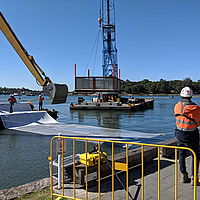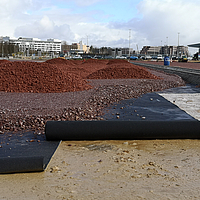Storage of sediments without treatment
Remediation of contaminated sites and soil
Environmental protection through treatment of contaminated soils
Safe and sustainable treatment methods for contaminated soils and sediments are playing an increasingly important role in environmental protection. Holistic solutions not only ensure effective results, but also actively contribute to environmental preservation. HUESKER understands the challenges posed by environmental pollution and offers project-specific product combination options for a wide range of applications in the areas of decontamination, securing and remediation of contaminated soils, sediments, and sludge.
Our experienced experts support projects from the soil analysis phase through geotechnical advice, providing recommendations for securing and remediation methods. The focus is on the safe and sustainable improvement of contaminated areas. This long-term approach minimizes the risk of recontamination avoiding additional re-treatment costs.
The extensive product range and customer-oriented engineering services not only take into account a wide range of applications, but also prepare for project-specific challenges related to legal requirements and obligations, such as clean-up mandates under the polluter-pays principle. Thanks to the environmentally friendly and cost-effective treatment methods, the products not only aim to eliminate pollution, but also minimize the risk of further environmental impacts.
With the specialist knowledge and the extensive experience of our experts, project partners can confidently select the most appropriate treatment method for their contaminated site, ensuring long term compliance with legal requirements and the environmental compatibility of their activities.

Efficient securing and renovation
with minimal time investment

Safe and cost-effective treatment
of soils and sediments

Sustainable and environmentally friendly
treatment methods

Experienced experts along with
a wide range of product combinations
Geotextile protection measures as part of contaminated site remediation
Protection for people and nature through hazard prevention
"A landfill cell, properly installed and tested for integrity, that is constructed with a composite liner system using a product with PFAS absorption capabilities should be considered to be the state-of-practice at this time, offering the greatest potential for successful PFAS containment and long-term storage."
Boyd Ramsey
"Sediment Capping with amendment layers has significantly changed our aqueous remediation efforts, providing a cost-effective and efficient solution to manage contaminated sediments.
The technique’s ability to isolate pollutants, prevent their migration, and promote natural recovery processes has a huge impact of aquatic ecosystems."
Danny Reible
"Geosynthetic pollutant filters represent an innovative approach to controlling the spread of pollutants from diffuse sources across various applications. The concept of treating leachate or vapours in situ introduces novel methods for the remediation and containment of contaminated soils and sediments, offering sustainable solutions for managing environmental pollution, particularly in soil and sediment encapsulation projects."
Malek Bouazza
Our geotextile products for soil remediation and remediation of contaminated sites
Our diverse product range and customer-focused engineering services enable active environmental protection through innovative treatment methods. Our wide array of solutions is customized to meet the specific needs of each project. Using geotextiles not only eliminates contamination but also reduces the risk of further environmental pollution.
Discover our products and their advantages.
The geotextile concrete mattress seals and protects against erosion and mechanical damage.
The world's strongest woven reinforcement fabric for ballast fill on soft soils.
The fast and cost-effective dewatering solution for various sludges.
The large-format coastal protection tubes pack the sand in an erosion-proof manner in order to protect the coasts and shore.
The pollutant barrier can be installed evenly and erosion-proof on land and under water.
The safe pollutant barrier for inorganic pollutants creates an impenetrable barrier against lead, mercury, and arsenic.
The safe contaminant barrier for organic pollutants reliably secures and remediates contaminated soil and water.
The pollutant barrier for absorbing oil, gasoline, diesel, and paraffin in infrastructure projects.
The high-performance geosynthetic clay liner for groundwater protection and contaminated sites remediation.
Efficient soil and contaminated site remediation with geosynthetics






























